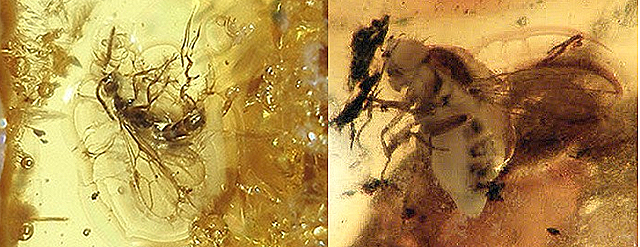General Discussion
Related: Editorials & Other Articles, Issue Forums, Alliance Forums, Region ForumsEarly Insect Camouflage
I've always felt that all things have a sense of presence, some more developed than others and no two species alikeThe insect is the larval form of a new genus and species, dubbed Hallucinochrysa diogenesi, and is a very distant relative of modern green lacewings. Like modern lacewing larva, the fossilized insect appears to have surrounded itself with plant filaments attached to protrusions on its body; hiding its presence from would-be predators—a process known as trash collecting (or carrying) in modern insects. Because the larva would have needed to pick and choose the material to be used as camouflage, this provides evidence for complex intelligent behavior in early insects.
Previously, the oldest known evidence for this kind of behavior came from Dominican amber dating back around 49 million years. The new discovery reveals camouflage as a defensive behavior existed during the Cretaceous Period—and since the lacewing lineage goes back as far as the Jurassic Period, possibly much earlier.
http://listverse.com/2014/10/15/10-amazing-discoveries-preserved-in-amber/
I found this site while tooling along trying to keep quiet so my wife who was called in to work last night can get some sleep and I was following a link from an earlier post and wound up here. You know how it can be I'm sure. Anyways enjoy this little tidbit of knowledge, (if indeed it is true,) and explore the site some when you get a chance. I'm enjoying this so far.
bolding is mine
Xipe Totec
(43,890 posts)madokie
(51,076 posts)just no telling what might get ya' ![]()
randome
(34,845 posts)[hr][font color="blue"][center]Aspire to inspire.[/center][/font][hr]
frogmarch
(12,160 posts)Here are two of my insect inclusions. One is a thread-waist wasp and the other is a fly. Both inclusions are in Baltic amber. I have the technical info that came with them somewhere, but I can’t say where right off. Organization is not my strong point. (They came from Lithuania and took about 8 weeks to get here.)
The fly might be white because decomposition began before it was completely engulfed, and mold had set in. If the fly had decomposed inside the amber, there’d be a whitish cloud surrounding the fly from escaping body gases.

For Christmas several years ago I gave my then 8-year-old grandson a bunch (20+) amber pebbles with inclusions (mostly fungus gnats, flies and tiny beetles). I included a little jewelers loupe (he still wears it on a cord around his neck so he can examine interesting live bugs he comes across) and a really good glossy-covered paperback book about amber. He likes his amber bugs and has used them for several show-and-tell school reports. I’m pleased the amber turned out to be such a good educational gift. The pebbles weren’t expensive. I think I paid under $20 for the sack of them.
madokie
(51,076 posts)I like seeing things that prove that there has been life here a long fucking time before I got here and will still be a long time after I'm gone
I'm going to take my chance on maybe getting to slide by life again. What the heck do I have to loose
mike_c
(36,281 posts)Most insect behaviors are innate, patterned motor responses. Most are genetically hardwired. Lacewing larvae select debris based on criteria that took many generations to evolve, not on the basis of learned selection criteria that meet dynamic and changing needs during an individual larva's lifetime.
Another classic example of this is the architectural prowess of mound building termite colonies. Their constructions appear to require intelligence and creativity to design and build, but in reality individual colony members are just following innate, preprogrammed instruction sets encoded in their genes and actuated when their nervous systems receive the correct stimuli. They're biochemical machines, in essence.
That last statement isn't a value judgement. Having most of one's behaviors innately hardwired is of greater long term benefit than being "intelligent" or "creative" in the classic sense because insects live short lives in a very dangerous world (and reproduce only if they live to the end of their lifespan)-- having to learn correct responses to sensory stimuli would more often than not be fatal, whereas innate, hardwired behaviors pass correct responses from generation to generation, sidestepping the need for behavioral plasticity and learned responses.